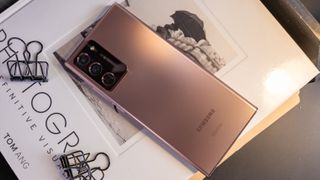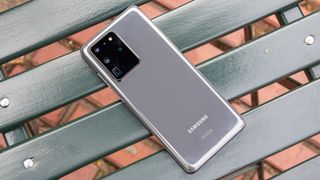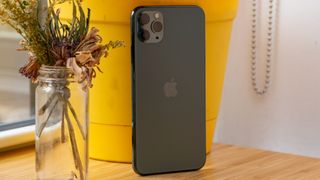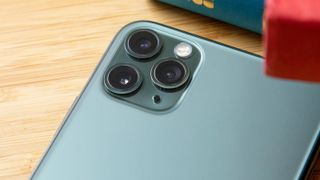Samsung Galaxy Note 20 Ultra vs iPhone 11 Pro Max vs Samsung Galaxy S20 Ultra
Three of the best

There have been a number of very big, very high-spec phones launched in the last year or so, and the latest of them is the Samsung Galaxy Note 20 Ultra, a massive, no-compromise handset, which landed alongside the standard Samsung Galaxy Note 20.
But impressive as it is, it has some similarly impressive competition, most notably from the iPhone 11 Pro Max, and another Samsung phone in the form of the Samsung Galaxy S20 Ultra.
It has a lot in common with the latter in particular, but all three of these phones could potentially appeal to the same audience, so to help you tell them apart and pick out the best one for your needs, we’ve compared their specs and features.

Design
The Samsung Galaxy Note 20 Ultra has a glass back, a metal frame, a big camera block on the top left corner of the back, and a punch-hole camera in the top center of the screen. It’s a fairly standard flagship look, but a bit more angular than some phones.
It comes in Mystic Bronze, Mystic Black or Mystic White, and it’s 164.8 x 77.2 x 8.1mm and 208g. Like most high-end handsets it’s also IP68 certified, so it can survive a splash or a spill.

The Samsung Galaxy S20 Ultra has a somewhat similar design, as you’d probably expect from the names. It too has a glass back, a metal frame, and similarly positioned cameras on both the front and back. It’s also IP68 certified, though it’s slightly curvier.
It comes in at 166.9 x 76 x 8.8mm and 220g, so it’s a little longer, thicker, and heavier than the Samsung Galaxy Note 20 Ultra, but not by much. Its colors also slightly differ, as you can get the Samsung Galaxy S20 Ultra in Cosmic Grey, Cosmic Black, or Cloud White.
Get daily insight, inspiration and deals in your inbox
Get the hottest deals available in your inbox plus news, reviews, opinion, analysis and more from the TechRadar team.

Finally, there’s the iPhone 11 Pro Max, which is also packing a metal frame and a glass back, with a large camera block in a similar position, and IP68 water resistance. However the front is rather different, as while the Samsung phones have punch-hole cameras, the iPhone 11 Pro Max houses its selfie snapper in a large notch.
It also comes in different colors, namely Space Grey, Silver, Midnight Green, or Gold, and at 158 x 77.8 x 8.1mm and 226g it’s the heaviest and widest of the phones, but joint thinnest, and not as tall as either Samsung handset.
Screen
The Samsung Galaxy Note 20 Ultra has a 6.9-inch 1440 x 3088 AMOLED screen with 496 pixels per inch, a 19.3:9 aspect ratio, and a refresh rate of up to 120Hz.
The Samsung Galaxy S20 Ultra meanwhile is somewhat similar. Its screen is just as large at 6.9 inches, and it’s also curved, AMOLED, has a refresh rate of up to 120Hz, and a similar resolution of 1440 x 3200. That makes for 511 pixels per inch, so it’s ever so slightly sharper. It also has a slightly different aspect ratio of 20:9.

The iPhone 11 Pro Max is the odd one out, as it’s smaller at 6.5 inches, slightly lower resolution at 1242 x 2688 (for 458 pixels per inch), flat to the edges rather than curved, and has a 60Hz refresh rate. Its aspect ratio is 19.5:9, and it has an AMOLED screen.
Still, these are all large, sharp displays, so the main obvious difference is just whether they’re curved, as is the case of the Samsung phones, or not, as in the case of Apple’s.
Camera
You get a 108MP f/1.8 main camera on the Samsung Galaxy Note 20 Ultra, and that’s joined by a 12MP f/3.0 telephoto one and a 12MP f/2.2 ultra-wide one. The main and telephoto lenses have optical image stabilization (OIS) and the phone is capable of 5x optical zoom and 50x ‘Space Zoom’, which is largely digital.
The phone can shoot up to 8K video at 24fps, and it also has a 10MP f/2.2 front-facing camera.

The Samsung Galaxy S20 Ultra has the Note 20 Ultra’s camera setup beat in some ways, at least on paper, as while it too has a 108MP f/1.8 main camera, that’s joined by a 48MP f/3.5 telephoto one, a 12MP f/2.2 ultra-wide one, and a depth sensor.
So you get more megapixels from the telephoto snapper, and the addition of a fourth sensor for judging depth. The S20 Ultra can also zoom in further, with 5x optical, 10x hybrid, and 100x digital zoom. Having said all that, it has smaller pixels on the telephoto camera than the Note 20 Ultra, which is something that should work in the Note’s favor.
Like the Note 20 Ultra it has OIS on the main and telephoto cameras, and it can record video in up to 8K quality at 24fps. However, its front-facing camera is a 40MP f/2.2 one.

Finally, the iPhone 11 Pro Max has a triple-lens camera with a 12MP f/1.8 main sensor, a 12MP f/2.0 telephoto one, and a 12MP f/2.4 ultra-wide one. The main and telephoto lenses have OIS, and it’s capable of 2x optical zoom. Video recording meanwhile tops out at 4K at 60fps, and there’s a 12MP f/2.2 front-facing camera.
So the iPhone loses out on megapixels and zoom, but in our review we were fairly impressed with the camera – especially its night mode. The Galaxy S20 Ultra meanwhile we found to have a good but inconsistent camera. It remains to be seen how the Note 20 Ultra will perform in practice.
Battery life
The Samsung Galaxy Note 20 Ultra has a 4,500mAh battery with 25W fast charging, but this is another area where on paper at least it’s a step down from the Samsung Galaxy S20 Ultra, as that has a 5,000mAh battery with up to 45W fast charging.
The iPhone 11 Pro Max though is another step down, as it has a 3,969mAh battery with 18W fast charging. Though remember it also has a slightly smaller screen, so should be less battery hungry. All three phones also support wireless charging.
As for how long the batteries actually last, we don’t know yet for the Note 20 Ultra, but in our reviews we found that both the Samsung Galaxy S20 Ultra and iPhone 11 Pro Max managed over 24 hours of life between charges, with the iPhone potentially stretching much of the way through a second day.

Specs and features
These are all flagship phones so they all have plenty of power, but they’re not totally equal on that front. The Samsung Galaxy Note 20 Ultra has either a Snapdragon 865 Plus chipset (if you’re in the US) or an Exynos 990 one (elsewhere). They’re both the top of their respective ranges, but the 865 Plus is newer and likely slightly better overall.
The Samsung Galaxy S20 Ultra has a similar split, but it uses the standard Snapdragon 865 in the US and the Exynos 990 elsewhere, so it’s a less powerful phone than the Note in the US, but - in terms of the chipset at least - there’s no difference between this and the Note 20 Ultra in most other regions.
Then there’s the iPhone 11 Pro Max, which uses Apple’s A13 Bionic chipset in all regions. This too is a top-end processor.
For RAM, you get 12GB in the Samsung Galaxy Note 20 Ultra, up to 16GB in the S20 Ultra, and just 4GB in the iPhone 11 Pro Max, but despite that Apple’s phones tend to match or beat the best Android rivals for performance.
It's worth noting though that while the Note 20 Ultra and S20 Ultra support 5G, the iPhone 11 Pro Max doesn't.
Storage meanwhile comes in at 128GB, 256GB, or 512GB in the Samsung Galaxy Note 20 Ultra, 128GB or 512GB in the Samsung Galaxy S20 Ultra, and 64GB, 256GB, or 512GB in the iPhone 11 Pro Max. So they all top out at the same level, but the Note 20 Ultra and S20 Ultra additionally have microSD card slots, which the iPhone doesn’t.

In terms of features, the main one to highlight is that with the Galaxy Note 20 Ultra you get an S Pen stylus, which is not a feature of the other phones. The two Samsung phones also have in-screen fingerprint scanners, while the iPhone 11 Pro Max goes all in on facial recognition for unlocking.
And it’s worth quickly highlighting the operating systems too – you’re getting Android (specifically Android 10) on both Samsung phones, while the iPhone 11 Pro Max runs iOS 13.
Price and availability
The Samsung Galaxy Note 20 Ultra has a starting price of $1,299 / £1,179, for which you get 12GB of RAM along with 128GB of storage in the US or 256GB of storage in the UK. It’s available from August 21, but Samsung Galaxy Note 20 deals for pre-orders start on August 5 in the UK and August 6 in the US. Australian details aren't available at the time of writing.
The Samsung Galaxy S20 Ultra is available now and starts at $1,399 / £1,199 / AU$1,999, which gets you 128GB of storage and 12GB of RAM.
Finally, the iPhone 11 Pro Max starts at $1,099 / £1,149 / AU$1,899 for 64GB of storage and 4GB of RAM.
So the iPhone has the lowest starting price but also comes with the least storage for that money, and the Samsung Galaxy S20 Ultra is theoretically the most expensive – at least in terms of starting price – but as it’s been out a while you can often find it for less than its standard price.

Takeaway
Based on all of the above, the main difference between the Samsung Galaxy Note 20 Ultra and S20 Ultra could simply be that one comes with a stylus while the other doesn’t. Their screens and designs are very similar, and there shouldn’t be a huge difference in power (though in the US the Note 20 Ultra likely has the edge).
The cameras do differ a bit, though it’s not clear which is better yet on that front, and the Galaxy S20 Ultra has a bigger battery, but that’s the extent of the main differences.
The iPhone 11 Pro Max, on the other hand, is quite different. It has a smaller, flatter screen, as well as a smaller (but long-lasting) battery, less RAM, a rather different design (especially with its notch) and less zoom potential from its camera. The biggest difference here though is the operating system, as it’s the only one of the three not to run Android. But it’s still big, and very powerful.
If you’re an Apple fan then your choice is clear, but things are less clear-cut for fans of Android or those open to either operating system. Given how much these phones cost, we’d suggest reading our full reviews before making a decision.
- After other options? Check out the best phones
James is a freelance phones, tablets and wearables writer and sub-editor at TechRadar. He has a love for everything ‘smart’, from watches to lights, and can often be found arguing with AI assistants or drowning in the latest apps. James also contributes to 3G.co.uk, 4G.co.uk and 5G.co.uk and has written for T3, Digital Camera World, Clarity Media and others, with work on the web, in print and on TV.

